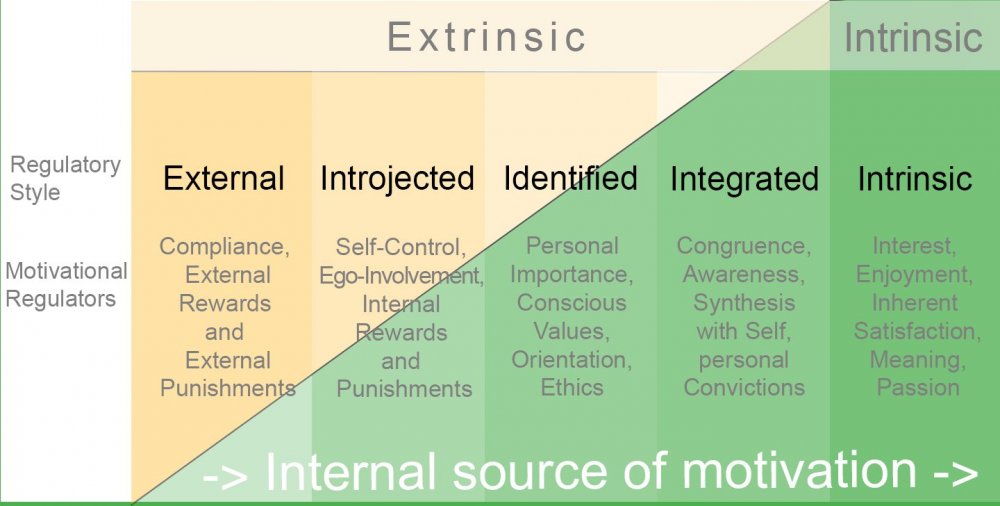The first survey about general causes for Stress at Work was designed to give you a quick idea about the different aspects that play a role in our well-being in our jobs. This time we'll look specifically at motivation and the results of the Motivation at Work Questionnaire.
What is motivation?
Motivation can be defined as internal and external factors that stimulate desire and energy in us to be continually interested and committed to a job, role or subject, or to make an effort to attain a goal.
Motivation is the most significant predictor of success. [...] the longer someone is in a career, the less important innate ability (i.e., intelligence) is, and the more important motivation becomes [...] high motivation will ensure total preparation which will, in turn, ensure maximum performance and results. [2]
Motivation results from the interaction of both conscious and unconscious factors such as the intensity of desire or need, incentive or reward value of the goal, and expectations of the individual and his or her peers. These factors are the reasons we have for behaving a certain way. [3] To understand what influences our motivation, let's take a closer look at Self-Determination Theory and the different aspects of motivation.
If you haven't done so yet, now is a good time to answer the motivation at work questionnaire. It takes less than five minutes, and you'll investigate what gives you real motivation at work and what issues to address that hinder you in reaching your full potential.
Motivation at work questionnaire
Self-Determination Theory
Self-Determination Theory (SDT; Ryan and Deci 2000) is a metatheory defining the psychological factors required for optimal motivation, engagement and well-being, concerned with how the individual interacts with and depends on the social and therefore work environment. SDT is based on the fundamental humanistic assumption that individuals naturally and actively orient themselves toward growth and self-organisation. [7]
In SDT the basic psychological needs of competence, autonomy and relatedness and their indispensable role in self-determined motivation, well-being, and growth are the central aspects. We are continuously involved in a dynamic interaction with the social world – at once striving for need, satisfaction, and also responding to the conditions of the environment that either support or thwart needs. As a consequence of this person-environment interplay, we become either engaged, curious, connected, and whole, or demotivated, ineffective, and detached. [7]
Let's take a closer look at the above mentioned three aspects of SDT on which our questionnaire is focused:
-
Competence - the need to feel effective in interactions with the environment
This need concerns our achievements, knowledge and skills; we need to build our competence and develop mastery over tasks that are important to us.
-
Autonomy - the need to feel free and self-directed, to experience personal endorsement
We need to feel that we are the masters of our destiny and that we have at least some control over our lives; most importantly, we need to feel that we are in control of our behaviour.
-
Relatedness - the need to feel meaningfully connected/connect closely with others
We need to have a sense of belonging and connectedness with others; each of us needs other people to some degree. [7][8]
These three factors influence our motivation. We can now look at the different aspects of motivation through the lens of our individual replies in the motivation at work questionnaire.
Different aspects of motivation
There are several areas where we can make insightful distinctions when looking at motivation such as negative and positive motivation, extrinsic and intrinsic motivation and aspirations, autonomous and controlled motivation. They are all influenced by the above mentioned three key factors of SDT. In the questionnaire, we focused on the level of fulfilment of those three factors.
Negative motivation and positive motivation
The two poles here are threats/punishment (negative motivation) versus positive motivation, such as rewards/satisfaction/joy. Take a moment to think about situations where you were motivated either positively or negatively. As you will see, both can be highly motivating, but from the perspective of well-being, self-development and happiness, positive motivation is much more satisfying.
External/extrinsic motivation and Internal/ intrinsic motivation
“The relationship between intrinsic and extrinsic motivation: doing things because you like doing them in their own right [intrinsic] or doing them because you want a reward that has been offered. [extrinsic]” [1] Examples of extrinsic motivation are grading systems, employee evaluations, awards, and the respect and admiration of others. Intrinsic motivation can be seen as living true to our core values, our interests, and our sense of morality.
Extrinsic Aspirations and Intrinsic Aspirations
The distinction between extrinsic and intrinsic aspirations (life goals) is quite similar to the motivation mentioned above. Aspirations are long-term goals which guide our activities, and they fall into two categories: extrinsic aspirations like wealth, fame and attractiveness, and intrinsic aspirations like affiliation, generativity and personal development. There have been several studies on this subject that intrinsic goals being associated with greater health, well being and performance. [5][6]
The problem with external motivators and aspirations is that crucial factors that influence our performance at work like creativity can't be consciously controlled.
Dan Ariely (Cognitive Psychology (PhD) Business Administration (PhD) ) explains it on the example of offering a bigger bonus for better performance. The bonus is an external-positive motivator, but still has its challenges: “If I gave you a bigger bonus to jump you would jump more times," says Ariely. "You have very good control over your legs, and if I give you more money you will transmit more power to them, and therefore you will be more successful. We don’t have the same control over memory, creativity and concentration. You can’t will yourself into a higher state of concentration and creativity. It’s counterproductive and hinders performance strongly.” [1]
So, even if an external-positive motivator like a bonus is motivating in a sense that we get aroused and activated, it doesn't reliably result in better performance. It's not surprising that it will work even less with a negative motivator like the fear of losing your job.
So, let's look at intrinsic motivators. The negative motivators, like fear of failure or a feeling of inadequacy, are worth being addressed for the sake of our personal development. If we act driven by anxiety or feeling "not good enough" it might make us work harder, but in the long run, this is not nourishing and holds us back from living our best life.
As we learned in the definition above, intrinsic motivation means that we do things because we like doing them in their own right.
Internal-positive motivation is coming from a place of strength, security and values. Therefore, it's the best form of motivation not only regarding our productivity at work but for our overall well-being and personal development.
As so often things are not only the two extremes of – in our case extrinsic and intrinsic – but there's a whole range between those two poles at which we will look now in a more differentiated way.
Autonomous motivation and Controlled motivation
Autonomous motivation includes motivation that comes from internal sources and encompasses motivation from extrinsic sources for individuals who identify with an activity’s value and how it aligns with their sense of self. It is displayed in green in the chart.
Controlled motivation is comprised of external regulation — a type of motivation where an individual acts out of the desire for external rewards or fear of punishment. On the other hand, introjected regulation is motivation from “partially internalised activities and values” such as avoiding shame, seeking approval, and protecting the ego. [8]
People adapt and orient themselves to their environment and their degree of self-determination in general, across many different contexts. Autonomy and what we perceive as autonomous decisions play an important role:
- Autonomous motivation: all three basic needs – competence, autonomy and relatedness – are satisfied.
- Controlled motivation: competence and relatedness are somewhat satisfied, but autonomy is not.
Both internal and environmental forces influence intrinsic motivation. The context – including external forces (e.g., deadlines), interpersonal climates (e.g., praise, instruction), and internal events (e.g., being ego-involved) – affects intrinsic motivation as a function of the degree to which they are fulfilled.
Here we can divide between different five regulatory styles that are deeply rooted in the three key factors of autonomy, competence, and relatedness with autonomy playing a central role.
While having these needs met is a source of motivation, the lack of them being met is a source of stress, dissatisfaction, lack of motivation and frustration at work. The survey captures the degree to which these basic needs are being met for you at work and to identify areas which need to be addressed and improved.
Participate in the happiness forum
- What was your overall SDT score, and how does it relate to your self-evaluation?
- How are you doing in these three different areas? Did you identify an area that is well developed while another could use a boost?
- Which areas can you identify where you are doing well in your job and why?
- Which areas can be improved, and what specific measures could help with that?
- What are your next steps?
Sources:
- [1] https://www.bbc.com/future/article/20120509-is-it-all-about-the-money (07/06/2020)
- [2] https://www.psychologytoday.com/us/blog/the-power-prime/201201/personal-growth-motivation-the-drive-change (12/06/2020)
- [3] http://www.businessdictionary.com/definition/motivation.html (28/06/2020)
- [4] https://courses.edx.org/courses/course-v1:BerkeleyX+GG202x+1T2020/course/ (29/05/2020)
- [5] https://en.wikipedia.org/wiki/Self-determination_theory#Basic_needs_and_intrinsic_motivation (29/05/2020)
- [6] http://citeseerx.ist.psu.edu/viewdoc/download?doi=10.1.1.90.1443&rep=rep1&type=pdf (29/05/2020)
- [7] https://www.researchgate.net/publication/317690916_Self-Determination_Theory (22/05/2020)
- [8] https://positivepsychology.com/self-determination-theory/(28/06/2020)
Photo by Stephen Leonardi, Thao Le Hoang, Ian Schneider on Unsplash
Written by Tine Steiss
 Tine is an artist, meditator, media engineer, activist and MBSR teacher. If she's not reading or writing she's working on turning her city garden into an edible paradise. Find out more about Tine on herrberta.art.
Tine is an artist, meditator, media engineer, activist and MBSR teacher. If she's not reading or writing she's working on turning her city garden into an edible paradise. Find out more about Tine on herrberta.art.







Join the conversation
You are posting as a guest. If you have an account, sign in now to post with your account.
There are no comments to display.